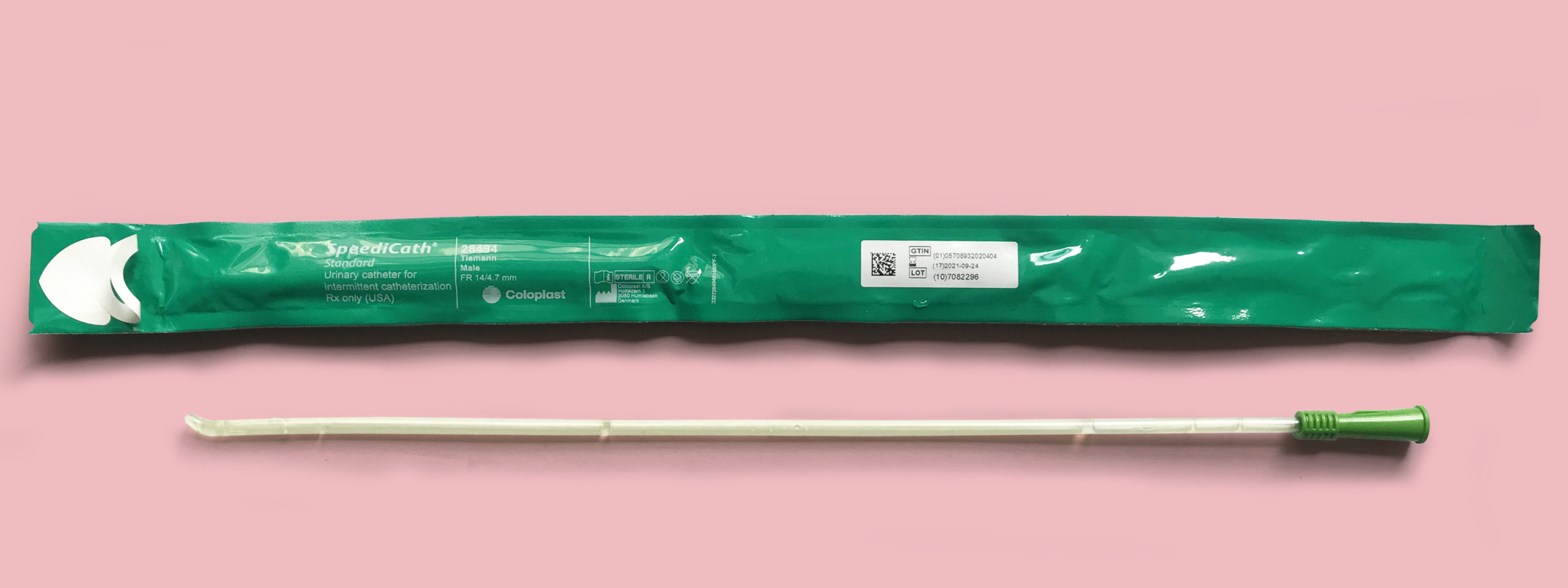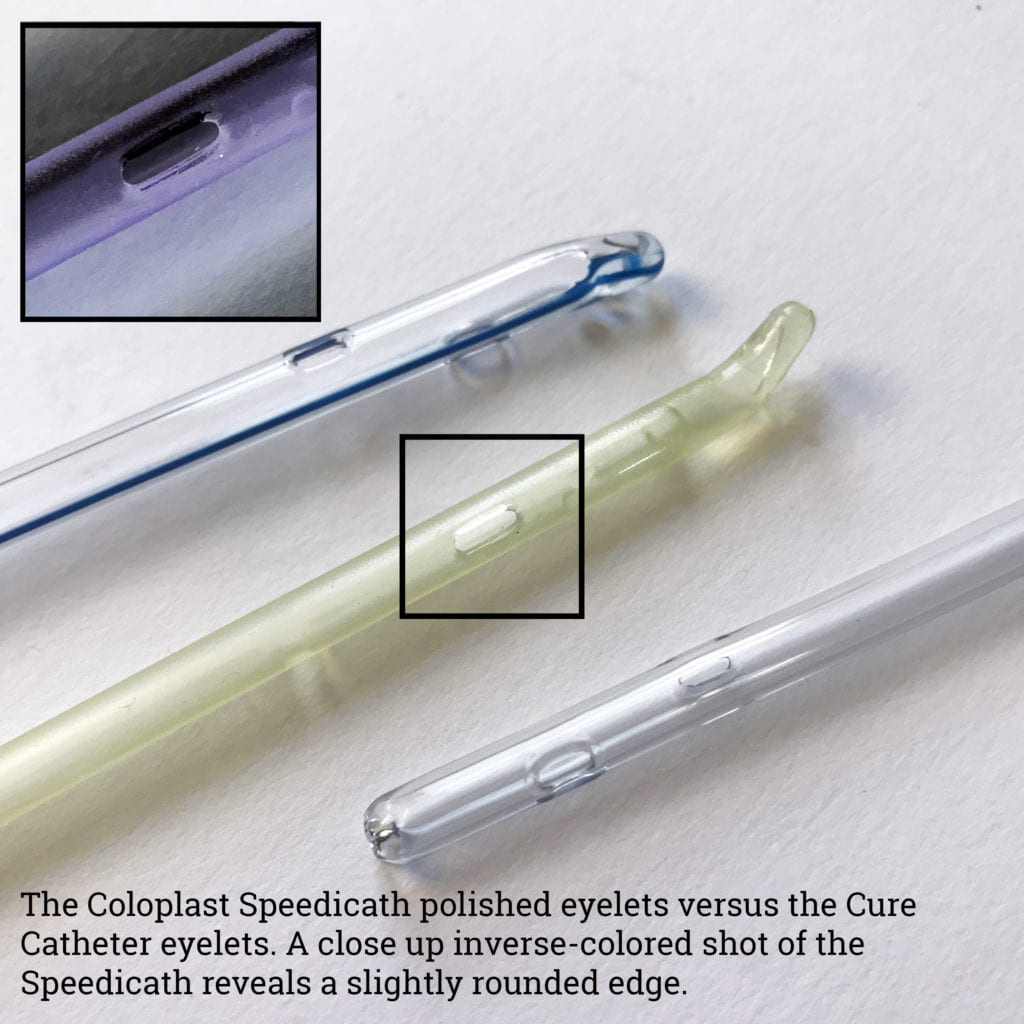Coloplast SpeediCath

Product Overview
Available Lengths: 14 inches (Male); 12 inches (Boys), 6 inches (Female and Pediatric)
Available French Sizes: 6 (Boys, Female & Pediatric only), 8, 10, 12, 14, 16, 18 (Male only)
Available Tips: Coudé (Taper Tip) and Standard
Pros
The stiffness of this catheter makes it easier to handle and insert than the competition.
Our Verdict
This is a very solid, convenient, and compact choice for an intermittent catheter, especially if its shorter than average length and hydrophilic coating don’t cause any issues for you.
Cons
Unlike other catheters in its category this catheter doesn’t come packaged with an insertion sleeve.
Uneven deposition of lubrication can give this catheter a rough and grainy surface.
Material
The Speedicath® is a ready-to-use catheter that is made out of polyurethane, which sets it apart from many other catheters. Polyurethane is non-toxic and is a more expensive plastic than PVC, which is cheap but can negatively impact human health. Polyurethane can actually soften slightly at body temperature, potentially making it easier to insert once it’s inside the body. Polyurethane has good biocompatibility, and isn’t known to cause allergic reactions. It has unique chemistry owing to the fact that it is a segmented polymer that gives it both flexibility and strength.
The catheter is coated with a hydrophilic coating made out of polyvinyl pyrrolidone (PVP). More on PVP below in the lubrication section!
Flexibility

This catheter is among the stiffest male catheters that we’ve tested. When held by the funnel, it droops down 7.5 inches while extending out 11 inches. That makes this catheter stiffer than the Bard Magic3 Go or the GC Glide (which is technically not ready to use like this is), and matches it with the LoFric Origo (also not ready to use). Unlike those catheters though, this one lacks an insertion sleeve.
The catheter’s stiffness means it’ll be easier to insert this catheter. One drawback to a stiffer catheter is the possibility that its use can lead to urethral trauma (the study in question focuses on indwelling catheters, but the logic should hold for intermittent catheters).
Packaging
The Speedicath® is a ready-to-use catheter that comes pre-hydrated in a foil-based package that keeps moisture in so that once you open it, it’s ready to be inserted. The package does have an easy-open pull tab that low-dexterity users can insert their fingers into to pull it open. The entire front face of the packaging rips open to present the catheter to the user.
There’s a sticker on the backside of the package that you can peel to stick your catheter package onto a wall while you get the rest of your supplies in order. This sticker isn’t easily accessible for someone with limited dexterity. Be careful when you use the sticker – we noticed that it had a tendency to pull paint off of walls.
Lubrication
PVP is the hydrophilic coating that gives this catheter its lubricious quality. PVP is generally considered to be safe, but can cause allergic reactions in rare cases – so check with your physician if you’re unsure as to whether or not this catheter is right for you. The catheter comes pre-hydrated, so you don’t need to pop any sachets to get this thing going.
For whatever reason, the surface of the Speedicath® seemed noticeably uneven or grainy, more so than even the Hollister®VaPro™, even when thoroughly hydrated. We could feel distinct differences in different regions of the catheter.
Insertion
Video training materials for these catheters (and more!) made by Coloplast® can be accessed here.
If you’re a man using this product, it’s can be hard to use without directly touching every inch of the catheter as it goes into your body. We’ve known folks who remove the packaging from the catheter, and then use it to handle the catheter without touching it directly. That might be worth a shot to reduce infection potential if you think the packaging is cleaner than your hands are.
We find that hydrophilic catheters typically come with insertion sleeves. Since polyurethane is so much more expensive than PVC, that might be a reason why an insertion sleeve isn’t typically included with this catheter.
You can get Speedicath® catheters with insertion supplies, but this is billed under a completely different reimbursement code (A4353) that is reimbursed at a higher per-catheter rate ($8.12). This means you’ll need additional documentation from your physician to qualify for insurance coverage.

The marketing materials for this catheter state that they have polished eyelets, and they feature a slight radius on them. But again, we use the Cure Catheter® as the standard here, and the Speedicath® eyelets don’t compare. They are thinner, which some studies have suggested lead to less urethral trauma because the urethral tissue doesn’t get caught in them as much as they would in larger eyelets.
Adverse Events
There were 4 product complaints for the Speedicath® catheters for all of 2019.
These complaints included: bleeding (from someone who wasn’t properly trained on how to use the coudé-tipped variant of the catheter – this individual sustained a UTI); another who developed a cyst on their prostate, which led to sepsis and ultimately death; another individual who developed some bleeding which led to 2 weeks of hospitalization (the bleeding was thought to be caused from improper usage of the catheter); and another fairly incomprehensible report that suggested that the cause of urethral bleeding was a foley catheter, not a Speedicath®.

The review of FDA Medical Device Reports from 2019 provides a limited snapshot of recent product performance in the marketplace.